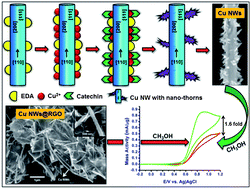Synthesis of copper nanowire decorated reduced graphene oxide for electro-oxidation of methanol†
Abstract
Hierarchical copper

* Corresponding authors
a
Department of Chemistry, National Taiwan University, 1, Section 4, Taipei 106, Taiwan
E-mail:
changht@ntu.edu.tw
Fax: +886-2-33661171
Tel: +886-2-3366117
b Department of Chemistry, Liaocheng University, Hunan Rd 1, Liaocheng, Shandong Province, China
c Institute of Bioscience and Biotechnology, National Taiwan Ocean University, 2, Pei-Ning Road, Keelung, Taiwan
Hierarchical copper

 Please wait while we load your content...
Something went wrong. Try again?
Please wait while we load your content...
Something went wrong. Try again?
A. P. Periasamy, J. Liu, H. Lin and H. Chang, J. Mater. Chem. A, 2013, 1, 5973 DOI: 10.1039/C3TA10745K
To request permission to reproduce material from this article, please go to the Copyright Clearance Center request page.
If you are an author contributing to an RSC publication, you do not need to request permission provided correct acknowledgement is given.
If you are the author of this article, you do not need to request permission to reproduce figures and diagrams provided correct acknowledgement is given. If you want to reproduce the whole article in a third-party publication (excluding your thesis/dissertation for which permission is not required) please go to the Copyright Clearance Center request page.
Read more about how to correctly acknowledge RSC content.
 Fetching data from CrossRef.
Fetching data from CrossRef.
This may take some time to load.
Loading related content
